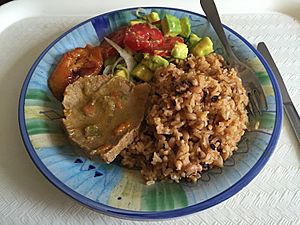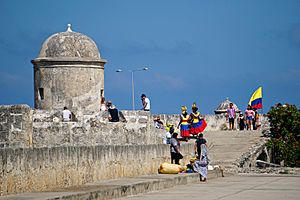Arroz de fríjol cabecita negra facts for kids
 |
|
| Alternative names | Arroz con fríjolito cabecita negra |
|---|---|
| Place of origin | |
| Region or state |
|
| Main ingredients | Black-eyed peas, rice, salt, water, vegetables |
| Variations | In Córdoba a variation is prepared where coconut milk is added. |
Arroz de fríjol cabecita negra is a yummy rice dish from the Caribbean Coast of Colombia. It's special because it uses black-eyed peas, which are a type of bean. Many other rice dishes use different kinds of beans or peas, but this one always features the black-eyed pea. It's a popular and tasty meal in this part of Colombia!
A Taste of History
- Further information: Slavery in Colombia

The story behind Arroz de fríjol cabecita negra isn't fully written down. But we know it's found in cities like Cartagena and other places along Colombia's Caribbean coast.
This dish is quite similar to a dish called Hoppin' John from the Southern United States. Both Cartagena and Charleston in the US have long histories connected to the Trans-Atlantic slave trade. This was a sad time when millions of people were brought from Africa to the Americas.
From the 1500s to the 1800s, over a million enslaved Africans arrived in Cartagena. These people brought with them important knowledge about plants and cooking. They knew about many vegetables, including the main ingredients of this dish.
Black-eyed Peas: A Journey
Cowpeas, which include black-eyed peas, first grew in West Africa. People started farming them there thousands of years ago. Old remains of cowpeas have been found in Ghana, dating back to about 2000 BC.
By the 1600s, cowpeas came to the Americas through the Trans-Atlantic slave trade. They became a very important food for enslaved people. We don't have many old records about cowpeas in Colombia specifically. However, different types of black-eyed peas still grow there today. Some are even special local kinds, like Kepshuna grown by the Wayúu in La Guajira.
Rice: A Global Staple
There are two main kinds of rice that people grow: Oryza sativa and Oryza glaberrima. Oryza sativa comes from East Asia and is the most common rice grown worldwide.
Oryza glaberrima is African rice. It's still grown in Sub-Saharan Africa today. Even though African rice isn't found in Colombia now, the knowledge of how to grow and cook rice came with the African people. This knowledge helped create many rice dishes across Latin America, including Arroz de fríjol cabecita negra.
How It's Made
Making Arroz de fríjol cabecita negra is quite simple.
- First, the black-eyed peas are soaked in water.
- Then, they are drained and put into a pot with salted water.
- The water is brought to a boil, then simmered until the peas are soft.
- The peas are drained again, but the cooking water is saved.
- Next, vegetables and seasonings are cooked in a pan.
- Finally, the cooked peas and the saved cooking liquid are added to the vegetables. Everything is mixed until it reaches the right consistency.
See also
 In Spanish: Arroz de fríjol cabecita negra para niños
In Spanish: Arroz de fríjol cabecita negra para niños

